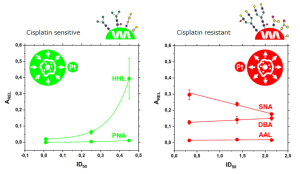A group from Institute of Chemistry, Slovak Academy of Sciences, Bratislava, Slovakia, has reported about difference in glycan structures between cisplatin sensitive and resistant testicular cancer (TC) cell lines.
https://pubmed.ncbi.nlm.nih.gov/35044085/
Testicular cancer is the most frequent type of cancer among young men aged between 15 and 34 years and represents 1.5% of all cancer types in men and 5% of urological tumours overall.
Cisplatin, as one of the very first metal-based chemotherapy drugs, is still widely used to treat patients with various types of cancers including TC. This drug is also effective in curing TC patients having metastases with cure rates of up to 90% and with a general survival rate of up to 95%. The reason why cisplatin works so effectively in treatment of GCTs is that such cells produce the embryonal stem cells. In turn, damaged embryonal stem cells need to be eliminated through apoptosis in order not to pass on mutations to the next generation. Loss of this embryonic feature might lie behind the development of cisplatin resistance.
Cisplatin binds to DNA and creates lesions (i.e. protein–DNA complexes and inter/intra-strand DNA adducts) which cannot be repaired by the DNA repair mechanisms, resulting in a disruption of synthesis of DNA, mRNA and proteins, promoting the accumulation of reactive oxygen species, activating signalling pathways and finally resulting in cell death.
Authors have found that DBA lectin could be the best probe for evaluating the resistance of TC lines, and also that HHL lectin could be used to prospect for cisplatin sensitive TC lines.
 Correlation between lectin binding to human chorionic gonadotropin (hCG) of sensitive/resistant testicular cancer cell lines with cisplatin ID50
Correlation between lectin binding to human chorionic gonadotropin (hCG) of sensitive/resistant testicular cancer cell lines with cisplatin ID50
